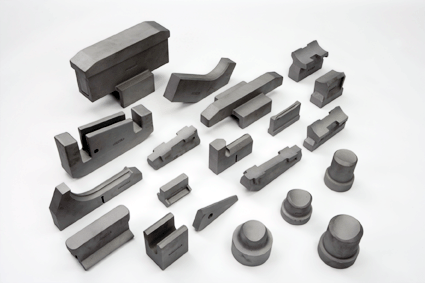Common Materials for Casting Engine Parts
Common Materials for Casting Engine Parts
The most common materials for casting engine parts are iron base alloy steels. The piston ring, piston pin, turbo charger, and the exhaust manifold all typically use stainless steel, while low alloy steels will suffice with proper heat treatments. Mechanical parts for all industries are often divided into general parts and special parts and are also distinguished according to their material of construction.
- A general-purpose part can be widely used in various machines
- A dedicated or special part can only be used in a specific type of machine.
KICastings works with a wide range of common materials for mechanical parts and CNC machining, especially for processes such as material management, product configuration, maintenance, repair, and overhaul, high-rate production, and more.
Ferrous and Nonferrous Metal Materials
Although many manufacturers avoid the ferrous vs. nonferrous groupings, it’s important for a machining team to understand the difference for high-speed machining applications.
- Ferrous materials include various steels, cast steels, and cast irons. These materials have good mechanical properties such as strength, ductility, and toughness, among others. In addition, ferrous materials are relatively inexpensive, readily available, and able to meet a variety of performance and application requirements. Among ferrous metals, alloy steels, stainless steels, tool steels, titanium, nickel, and others are used for aerospace materials. Alloy steel casting is perfect for projects that require wear and corrosion resistance with high-strength, while carbon steel casting is best for projects that require more strength, like springs and wires.
- Non-ferrous metal materials offer advantages in electrical, tubing, and pipework applications. Common nonferrous materials range from copper alloys, aluminum alloys, and brass. Non-ferrous materials offer the advantages of low density, good thermal conductivity, and are typically used in applications where friction, wear, and corrosion resistance are required. Considering bronze or brass for your project? Learn more about copper casting services.
Composite Materials
Composite materials combine two or more individual materials to obtain desired physical or mechanical properties and improve operational outcomes.
For example, non-metallic materials such as glass, graphite (carbon), boron, and plastic can be composited into various fiber-reinforced materials. A plastic composite steel plate with high strength and corrosion resistance can be obtained by attaching plastic to the surface of an ordinary carbon steel plate.
The main advantages of composite materials are their high strength and elastic modulus. The quality of these materials can be severely compromised, however, with disadvantages including poor heat resistance, limited heat conduction, and poor electrical conductivity. In addition, the price of composite materials is relatively expensive, which can limit their use to high-tech fields such as aviation and aerospace.
Choosing Materials for Engine Parts
Choosing the right material is an important part of an automotive casting order, and numerous factors should be considered, including:
- Workability/Use Requirements
- Pricing
- Weight
- Strength
- Corrosion Resistance
- Conductivity
The grades, properties, and heat treatment specifications of these materials are also an important part of the selection process. These can be found in the appropriate mechanical design manuals.
When selecting materials, the designer should fully understand the properties, conditions, and requirements of the material in question, along with the mechanical processes and economic constraints that affect production.
The following guide provides a brief introduction to the product selection process.
1. Use Requirements
The use requirements of an individual component refer to its working condition, the part size and quality, and the overall context of the component in relation to the machine.
- Working condition – In order to ensure proper use and avoid failure, it’s important to address the environmental characteristics, working temperature, friction, and wear of the parts. Working temperature is a crucial consideration, including the linear expansion coefficients between materials and how temperature affects the mechanical properties of a material. The magnitude and nature of the material under stress are also important, with this quality referred to as the load condition. In addition, the properties of metallic materials can often be improved with heat treatment.
- Part size and quality – The size and quality of the part are directly related to the type of material, along with the blank making process. When manufacturing blanks from cast materials, size and quality are generally not affected. When manufacturing blanks from forged materials, attention must be paid to the production capacity of the forging machinery and equipment. The size and mass of the part are also related to the weight-to-weight ratio of the material, with a large weight-to-weight ratio often advised for better quality.
- Context within the machine – It’s important to think about the context of the component from the outset, with materials, tolerance, and other issues all relative to the overall machine and project. While most contextual issues are related to the working condition of the individual component, it’s important to address the overall design across the entire scale of operation.
2. Process Requirements
It’s always necessary to consider how the materials are manufactured from blank to finished product. For complex structures and large dimensions that are difficult to forge, good casting or welding properties are needed instead.
- For casting, the liquidity of the material and its potential for shrinkage and segregation need to be considered.
- For welding, the weldability of the material and its tendency to crack need to be considered.
- For forging, the extensibility, hot brittleness, and deformability are important.
- For heat treatment, the hardness of the material needs to be considered, along with the tendency for quenching deformation.
- For parts to be machined, it’s important to consider the hardness, machinability, and degree of cold work needed.
- After cutting, the surface roughness needs to be considered.
3. Economic Requirements
It’s always necessary to consider how common materials for mechanical parts are manufactured from start to finished product. For complex structures and large dimensions that are difficult to forge, good casting or welding properties are needed instead.
- The relative price of the material itself should be as low as possible, especially for parts manufactured in large quantities.
- The processing cost of the materials, especially when the material itself is relatively affordable.
- The material utilization rate, which is the difference between the raw material weight and the actual weight of the finished part.
- The local quality principle, with different requirements dictating the use of different materials and heat treatment processes.
- The use of affordable materials to save valuable and rare materials due to supply or economic reasons.
- The types and specifications of materials used on the same machine should be reduced as much as possible for small-volume production.


 O.B.T Manufacture
O.B.T Manufacture 

